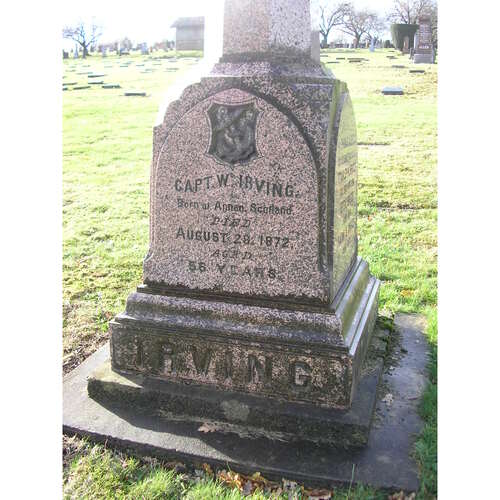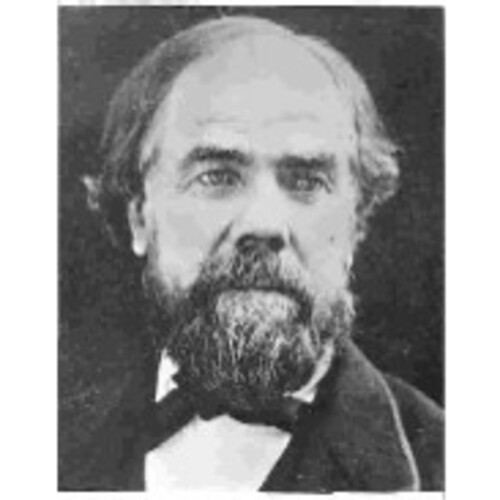
Source: Link
IRVING, WILLIAM, master mariner and shipowner; b. 10 March 1816 at Annan, Dumfrieshire, Scotland; d. 28 Aug. 1872 at New Westminster, B.C.
In William Irving’s youth Annan was a shipbuilding centre and his father was a shipwright in one of the yards. He himself went to sea as a cabin boy in the locally built brig Helen Douglas in 1831. Later he served in ships on the New York run, and it is said that he had some steamboating experience in New Brunswick.
Attracted to the Pacific coast by the gold discoveries in California, Captain Irving and an associate bought the bark Success and arrived at San Francisco in May 1849. In August, Irving moved to Portland, Oregon, where he later acquired extensive properties; a suburb of the city is still known as Irvington. In 1851 he became part owner of the steamer Eagle, the first of several steamers operating on the Columbia and Willamette rivers in which he had an interest. The gold rush to the Fraser River lured him north and in 1859 he purchased a share in the British Columbia and Victoria Steam Navigation Company. This he soon increased to a controlling interest. The company was operating the Governor Douglas, the first steamer built in British Columbia, between Victoria and New Westminster, as well as the Colonel Moody and Maria up the Fraser from New Westminster to Yale and to Harrison Lake.
The years 1862–65, which saw the height of the Cariboo gold rush, were a period of intense and often unscrupulous competition on the Fraser. Rate wars were frequent; competitors who had been paid subsidies to take their steamers off the river often sold them; whereupon the new owners would put them back in service. Steamboat inspection was lax, and boiler explosions not infrequent. Irving himself had a narrow escape in April 1861, when an explosion demolished the Fort Yale, a rival of his own ships, on which he happened to be travelling.
Irving was not satisfied with the ships he had acquired and he sold all three in May 1862. He had decided to concentrate on the run between New Westminster and Yale and ordered a new vessel specially designed for the service. This was the sternwheeler Reliance of about 300 tons, launched at Victoria in October, which proved to be the most successful Fraser River steamer of her time. In spite of strenuous competition, she proved, under Irving’s shrewd management, to be a consistent money-maker. In 1865 he built the 283-ton Onward, an improved version of the Reliance with more comfortable passenger accommodation, and she repeated the earlier ship’s success. By 1866, however, the Cariboo mines were declining and traffic on the Fraser declined with them. Only one competitor of Irving’s Pioneer Line had survived, and to cut costs the two companies agreed to operate their ships alternate years until trade improved.
Irving was by this time perhaps the most popular and prominent citizen of New Westminster. He served for several years on the city council and was its president in 1868. He had many business interests, including control of the Albion Iron Works in Victoria. A generous man, he would willingly carry free a passenger who was genuinely unable to pay his fare, but he was not one to be imposed upon. He was thus characterized by the Victoria Colonist at the time of his death: “An intrepid navigator, possessed of more than ordinary pluck and push, he had an open hand and a warm heart for the needy.”
In 1851 Irving had married Elizabeth Jane Dixon, who was born in Indiana. They had four daughters and one son. The home Irving built in New Westminster in 1864 was purchased from his granddaughters by the city of New Westminster and is now Irving House Historic Centre.
For a dozen years William Irving was the leading figure in shipping on the Fraser River. Under his son, Captain John Irving*, the Pioneer Line united with the coastal shipping interests of the Hudson’s Bay Company to form the Canadian Pacific Navigation Company which in 1901 became the British Columbia Coast Service of the Canadian Pacific Railway.
Colonist (Victoria), 1859–72. M. A. [Irving] Cox, Saga of a seafarer; the annals of Capt. William Irving (New Westminster, B.C., 1966). Lewis and Dryden’s marine history of the Pacific northwest (Wright). N. R. Hacking, “Steamboating on the Fraser in the ’sixties,” BCHQ, X (1946), 1–41; “British Columbia steamboat days, 1870–1883, I: Fraser and Stikine River steamboats,” BCHQ, XI (1947), 69–111.
Cite This Article
W. Kaye Lamb, “IRVING, WILLIAM,” in Dictionary of Canadian Biography, vol. 10, University of Toronto/Université Laval, 2003–, accessed December 31, 2025, https://www.biographi.ca/en/bio/irving_william_10E.html.
The citation above shows the format for footnotes and endnotes according to the Chicago manual of style (16th edition). Information to be used in other citation formats:
| Permalink: | https://www.biographi.ca/en/bio/irving_william_10E.html |
| Author of Article: | W. Kaye Lamb |
| Title of Article: | IRVING, WILLIAM |
| Publication Name: | Dictionary of Canadian Biography, vol. 10 |
| Publisher: | University of Toronto/Université Laval |
| Year of publication: | 1972 |
| Year of revision: | 1972 |
| Access Date: | December 31, 2025 |





